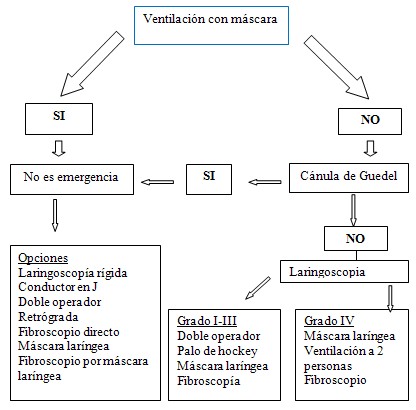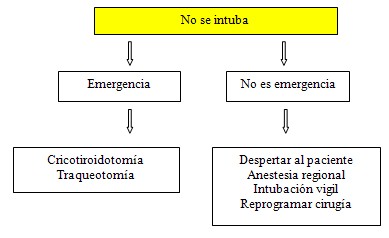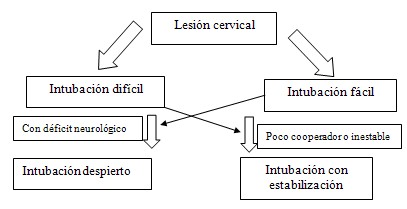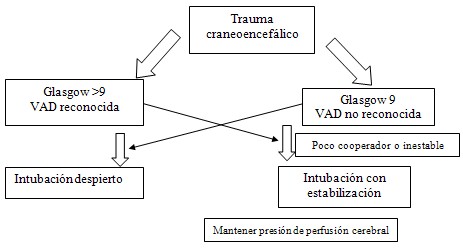Predictores y manejo de la via aerea dificil. Revision.4
Esquema 2. Algoritmo de vía aérea difícil inesperada.


Esquema 3. Algoritmo para lesión cervical y trauma craneoencefálico.


Bibliografía.
1. Murphy MF, Walls RM. The difficult and failed airway. In: Manual of emergency airway management. Chicago: Lippincott Williams and Wilkins, 2000:31–9.
2. MacKay CA, Terris J, Coats TJ. Prehospital rapid sequence induction by emergency physicians: is it safe? Emerg Med J 2001;18: 20–4.Graham CA, Beard D, Oglesby AJ, et al. Rapid sequence intubation in Scottish urban emergency departments. Emerg Med J 2003;20: 3–5.
3. Wilson ME, Spiegelhalter D, Robertson JA, et al. Predicting difficult intubation. Br J Anaesth 1988;61: 211–16.
4. Frerk CM. Predicting difficult intubation. Anaesthesia 1991;46: 1005–8.
5. Oates JDL, Macleod AD, Oates PD, et al. Comparison of two methods of predicting intubation difficulty. Br J Anaesth 1991;66: 305–9.
6. Mallampatti SR, Gatt SP, Gugino LD, et al. A clinical sign to predict difficult intubation: a prospective study. Can Anaesth Soc J. 1985; 32:429–34.
7. Rose DK, Cohen MM. The airway. Problems and prediction in 18500 patients. Can J Anaesth 1994;41: 372–83.
8. Reed MJ, Rennie LM, Dunn MJG, et al. Is the ‘LEMON’ method an easily applied emergency airway assessment tool? European Journal of Emergency
9. Medicine 2004;11: 154–7.
10. Eindhoven GB; Dercksen B; Regtien JG; Borg PA; Wierda JM. A practical clinical approach to management of the difficult airway. European Journal Of Anaesthesiology. Supplement [Eur J Anaesthesiol Suppl] 2001; Vol. 23, pp. 60-5.
11. Cormack RS, Lehane J. Difficult intubation in obstetrics. Anaesthesia. 2004;39: 1105–11.
12. Rocke DA, Murray WB, Rout CC, et al. Relative risk analysis of factors associated with difficult intubation in obstetric anesthesia. Anesthesiology 1992;77:67–73.
13. Sher A, Greenberg RS. New techniques in management of the difficult pediatric airway. Problems in Anesthesia 1998; 10: 416-33.
14. Tse JC. Rimm EB. Hussain A. Predicting difficult endotracheal intubation in surgical patients scheduled for general anesthesia: a prospective blind study, Anesth Analg 1995;81: 254–8.
15. El-Ganzouri AR, McCarthy RJ, Tuman KJ, et al. Preoperative airway assessment: predictive value of a multivariate risk index. Anesth Analg. 1996;82: 1197–204.
16. Arne J, Descoins P, Fusciardi J, et al. Preoperative assessment for difficult intubation in general and ENT surgery: predictive value of a clinical multivariate risk index. Br J Anaesth 1998;80: 140–6.
17. Eberhart LH. The reliability and validity of the upper lip bite test compared with the Mallampati classification to predict difficult laryngoscopy: an external prospective evaluation. Anesth Analg.2005 Jul;101(1):284-9.
18. Saghaei M, Safavi MR. Prediction of prolonged laryngoscopy. Anaesthesia 2001;56: 1181–201.
19. Baeza F, Peyton H, Grove I. Vía aérea difícil. Manejo y rendimiento de aparatos. Boletín de Anestesiología 2000; 16: 7-24.
20. Blanco G, Melman E, Cuairan V, Moyao D, Ortiz-Monasterio F. Fibreoptic nasal intubation in children with anticipated and unanticipated difficult intubation. Paediatric Anaesthesia 2001; 11: 49-53.
21. Crosby ET, Cooper RM, Douglas MJ, Doyle DJ, Hung OR. The unanticipated difficult airway with recommendations for management. Can J Anaesth 1998 Aug; Vol. 45 (8), pp. 757-76.
22. Rosenblatt WH, Wagner PJ, Ovassapian A, Kain ZN. Practice patterns in managing the difficult airway in the United States. Anesth Analg 1998; 87: 153-7.
23. Lopez M, Brinacombe J, Keller C. A Comparison of four methods for assessing oropharingeal leak pressure with the laryngeal mask airway (LMATM) in paediatric patients. Paediatric Anaesthesia 2001; 11: 319-21.
24. Shiga T, Wajima Z, Inoue T, Sakamoto A. Predicting difficult intubation in apparently normal patients: a meta-analysis of bedside screening test performance. Anesthesiology 2005; 103: 429-437.